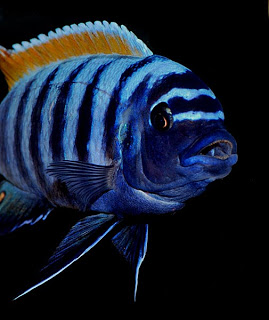|
|||||||||||||||
|

CLICK ON weeks 0 - 40 and follow along every 2 weeks of fetal development
|
||||||||||||||||||||||||||||
|
Regrow a tooth? Fish, yes! Humans, maybe ... When a Lake Malawi cichlid loses a tooth, a new one drops neatly into place as a replacement. Why can't we humans regrow our teeth lost to injury or disease? Working with hundreds of these colorful fish, researchers are beginning to understand how cichlids produce hundreds of teeth throughout their adult life. By understanding how tissues in embryonic cichlids become either teeth or taste buds, researchers hope to some day regenerate teeth in humans. Like other mammals, we only get two sets (baby and adult) to last our lifetime. The research was conducted by scientists from Georgia Institute of Technology in Atlanta, Georgia, and King's College in London, United Kingdom. It was published October 19 in an early edition of the journal Proceedings of the National Academy of Sciences or PNAS. The research was supported by the National Institute of Dental and Craniofacial Research, which is part of the U.S. National Institutes of Health.
Worldwide, nearly 60 percent of people have lost all their teeth by the time they reach the age of 60. Beyond the painful dental health issues, tooth loss can causes significant medical and nutritional problems that can shorten life. To understand more about pathways that lead to the growth and development of teeth, Streelman and first author Ryan Bloomquist - a DMD/PhD student at Georgia Tech and Georgia Regents University - studied how teeth and taste buds grow. Both structures eminate from the same epithelial tissue in embryonic fish. Unlike humans, fish have no tongues, so their taste buds are mixed in with their teeth, sometimes in adjacent rows located along the jaw. The Lake Malawi cichlids have adapted their teeth and taste buds to thrive in their unique living conditions. One species eats plankton and needs few teeth because it visually locates food and swallows it whole. Another species lives by scraping algae from rocky lake formations. This requires both more teeth and more taste buds to distinguish its food. Researchers crossed the two closely-related species, and in a second generation of these hybrids, saw substantial variation in the numbers of teeth and taste buds. By studying genetic deviation in some 300 of these second-generation hybrids, they found how to tease out genetic components causing teeth and taste bud variation. Streelman explains: "We were able to map regions of their genomes that correlated to the densities of each of these [two] structures. And through a collaboration with colleagues at King's College in London, we were able to demonstrate that in mice, a few poorly studied genes were also involved in the development of teeth and taste buds."
Epithelial cell changes begin five to six days after fish eggs are fertilized, at a stage when embryonic fish have eyes and a brain - but are still growing jaws. "There appear to be molecular switches that will shift the fate of the common epithelial cell to either dental or sensory structure," Streelman adds.
Streelman: "It's not until late in the development of a tooth that enamel and dentine form. In the earliest stages, these structures are really very similar." Studies in fish and mice suggest the possibility that with the right molecular signals, epithelial tissue in humans might also regenerate new teeth. "It was not previously thought that development would be so plastic for structures that are so different in adult fish," Streelman said. "Ultimately, this suggests that the epithelium in a human's mouth might also be more plastic than we previously thought. The direction our research is taking in terms of human health, is to figure out how to coax the epithelium to form one structure or the other." But growing new teeth won't be enough, Streelman cautions, we also need to understand how nerves and blood vessels grow inside a tooth.
Streelman and research technician Teresa Fowler are now working to determine how far into cichlid adulthood plasticity between teeth and taste buds extends, and how to trigger such a change. Abstract Abstract In addition to those already mentioned, the research included Nicholas Parnell and Kristine Phillips from Georgia Tech, and Tian Yu from King's College. This research is supported by the National Institute of Dental and Craniofacial Research, part of the U.S. National Institutes of Health, under grants 2R01DE019637 (to J.T.S.) and 5F30DE023013 (to R.F.B.). Any opinions or conclusions are those of the authors and may not necessarily represent the official views of the NIH. CITATION: Ryan F. Bloomquist, et al., "Co-Evolutionary Patterning of Teeth and Taste Buds," (Proceedings of the National Academy of Sciences, 2015). |
Oct 21, 2015 Fetal Timeline Maternal Timeline News News Archive
|
||||||||||||||||||||||||||||


